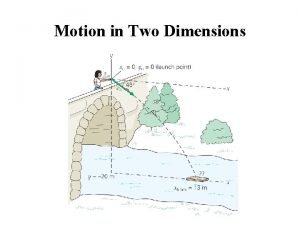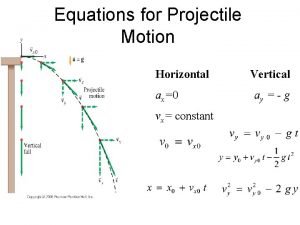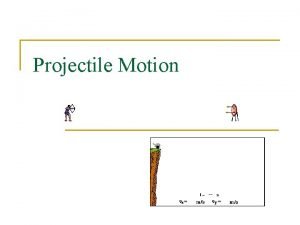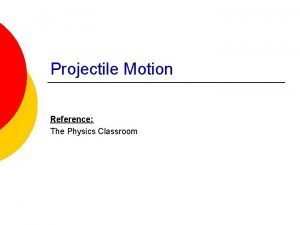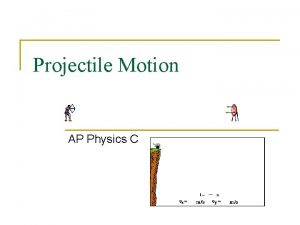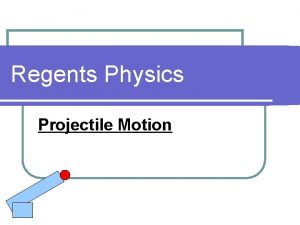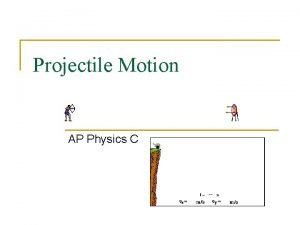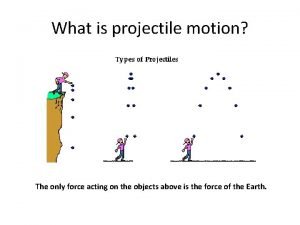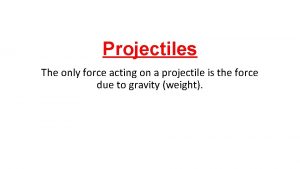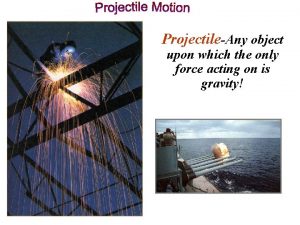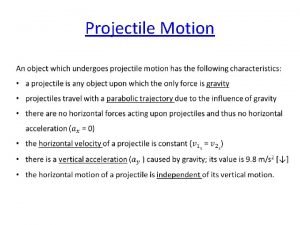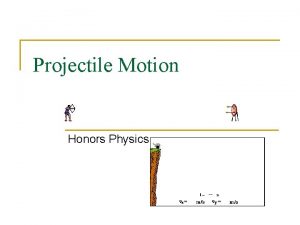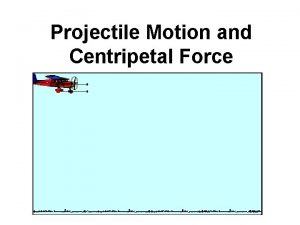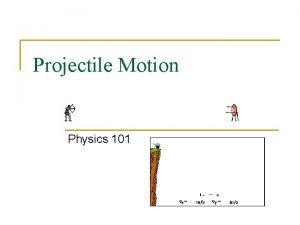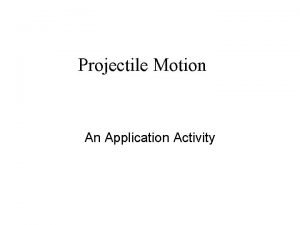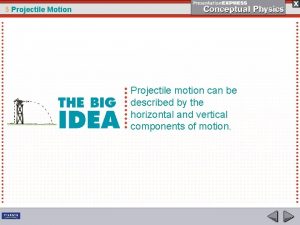Projectile Motion Physics Honors The Motion Formulas Good

































- Slides: 33

Projectile Motion Physics Honors

The Motion Formulas Good News/Bad News: These are the same formulas we used for linear motion. Do you know them? If the answer is “NO”, then memorize them NOW!

Things we know to be true about all projectiles. We assume NO AIR RESISTANCE! (Welcome to “Newtonia”), therefore… The path of a projectile is a parabola. Horizontal motion is constant velocity. Vertical motion is in “free-fall”. Vertical velocity at the top of the path is zero Time is the same for both horizontal and vertical motions.

How are the formulas different for projectiles? They must be applied along only one axis at a time. horizontal or “x” – direction vertical or “y” – direction 0 0 0 Remember that for projectiles, the horizontal and vertical motions must be separated analyzed independently. Remember that “ax” is zero and “ay” is acceleration due to gravity “g = 9. 81 m/s 2”.

Projectiles Launched Horizontally

A typical physics problem A cannon ball is shot horizontally from a cliff. height vx What do we know? For all projectiles… dy Range, dx Hint: You should always list your known values at the beginning of any problem and assign those values variables.

Where do we start? A cannon ball is shot horizontally from a cliff. height vx Knowns: dy Range, dx Remember to keep the horizontal and vertical motions separate. Time is the factor that ties them together. Since the vertical motion is treated like “free-fall” and we have more info about the vertical, we should use that to find time first.

Let’s put numbers on it. What do we want to find? A cannon ball is shot horizontally at 5 m/s from a cliff that is 35 m high. Find time, t = ? Find range, dx = ? Find final velocity, vf = ? Vx= 5 m/s Knowns: Givens: height dy=35 m Range, dx Add the given values to our list of known values. Now that the diagram is drawn and labeled and we have identified and listed all of our “known” and “given” values for the problem, let’s begin by finding time.

Finding time of flight for a horizontally launched projectile. A cannon ball is shot horizontally at 5 m/s from a cliff that is 35 m high. Find time of flight, t = ? Find range, dx = ? Find final velocity, vf = ? Vx= 5 m/s Knowns: Givens: height dy=35 m Range, dx Since we know more values for vertical motion, let’s use it to find time. Start with the distance equation… Now solve for t…

Finding range (horizontal distance) A cannon ball is shot horizontally at 5 m/s from a cliff that is 35 m high. Find time of flight, t = ? Find range, dx = ? Find final velocity, vf = ? Vx= 5 m/s Knowns: Givens: height dy=35 m Calculated: Range, dx Now that we know time, let’s find dx. Remember that horizontal motion is constant. Let’s use the distance formula again. This time in the x – direction… 0

Finding final velocity (magnitude and direction) A cannon ball is shot horizontally at 5 m/s from a cliff that is 35 m high. Find time of flight, t = ? Find range, dx = ? Find final velocity, vf = ? Vx= 5 m/s Knowns: Givens: dy=35 m height Vf Calculated: Range, dx Final velocity requires a little more thought. Remember that velocity is a vector quantity so we must state our answer as a magnitude (speed that the projectile strikes the ground) and direction (angle the projectile strikes the ground). Also remember horizontal velocity is constant, therefore the projectile will never strike the ground exactly at 90°. That means we need to look at the horizontal (x) and vertical (y) components that make up the final velocity.

Finding final velocity (magnitude and direction) A cannon ball is shot horizontally at 5 m/s from a cliff that is 35 m high. Find time of flight, t = ? Find range, dx = ? Find final velocity, vf = ? Vx= 5 m/s Knowns: Givens: dy=35 m height Vf Calculated: Range, dx Let’s look more closely at the vector, vf. To help see it better, let’s exaggerate the angle. Since x- and y- motion are separate, there must be components. θ Vfy Vf θ Vfx = 5 m/s So, we have the xcomponent already due to the fact that horizontal velocity is constant. Before we can find vf, we must find the vertical component, vfy.

Finding final velocity (magnitude and direction) A cannon ball is shot horizontally at 5 m/s from a cliff that is 35 m high. Find time of flight, t = ? Find range, dx = ? Find final velocity, vf = ? Vx= 5 m/s Knowns: Givens: dy=35 m height Vf Calculated: Range, dx To find vfy, remember that vertical motion is in “free-fall” so it is accelerated by gravity from zero to some value just before it hits the ground. θ Calculating vfy: Vfy Vf θ Vfx = 5 m/s Still not finished. Gotta put components together for final.

Finding final velocity (magnitude and direction) A cannon ball is shot horizontally at 5 m/s from a cliff that is 35 m high. Find time of flight, t = ? Find range, dx = ? Find final velocity, vf = ? Vx= 5 m/s Knowns: Givens: dy=35 m height Vf Calculated: Range, dx Putting it together to calculate vf: Vfy=26. 2 m/s Now we know both the xand y- components of the final velocity vector. We need to put them together for magnitude and direction of final velocity. θ Vfx = 5 m/s Final Velocity = 26. 7 m/s, 79. 2°

Projectiles Launched at an Angle

Separating the horizontal and vertical motions. viy vi θ vix Since the initial velocity represents motion in both the horizontal (x) and vertical (y) directions at the same time, we cannot use it in any of our equations. Remember, the most important thing about projectiles is that we must treat the horizontal (x) and vertical (y) completely separate from each other. So…we need to separate “vi” into its x- and y- components. We will use the method we used for vectors. vi viy θ vix Now that we have the components of the initial velocity, we will use only those for calculations. **Never use the original velocity at the angle in an equation!

Symmetry of the projectiles path. viy vi θ vfx vix vfy A projectile’s path is a parabola, ALWAYS. That means if a projectile is launched and lands at the same height, there will be symmetry. The angle of launch and angle of landing will be equal. The initial velocity and the final velocity will be the same magnitude. Also, that means the components will be the same. Since the horizontal motion is always at constant velocity… Since the vertical motion is the same as a ball that is thrown straight up or dropped straight down (in free-fall), the ycomponents are equal and opposite. vfy vf θ vfx

What do we know? Viy Vy top = 0 vi θ Vx dymax =height Range, dx Knowns (for all projectiles): Step 1: List known values! Draw and label picture.

Keeping the horizontal and vertical motions separate! Vy Vy top = 0 vi θ dymax =height Vx Range, dx Knowns (for all projectiles): Step 2: Divide initial velocity into horizontal (x) and vertical (y) components. Step 3: Find time if possible. Use vertical motion.

and end at the same height. (Using distance formula. ) Almost every projectile problem can be solved by starting with the displacement equation to solve for time. In this case… Vy top = 0 Vy vi θ dymax =height Range, dx Finding time – Method 1: Since the initial and final vertical positions are both the same, vertical displacement dy = 0. Note: There are three ways to find time for this problem. You may use any of them you wish. Now solve for time. Yes, it is a quadratic equation! This will be the time for the entire flight. NOTE: If you want to find maximum height you will only use half the time. If you want to find range, use the total time.

Finding time for projectiles that start and end at the same height. (using symmetry) Vy Vy top = 0 vi θ Vx dymax =height vf vfx θ vfy Range, dx Find time – Method 2: Use vertical motion and symmetry. Remember that the y component of initial and final velocities are equal and opposite. So using the formula plug in the known values from symmetry , vfy=-viy and solve for t. Note: usually any vectors acting upward such as initial velocity are considered to be positive, therefore acceleration due to gravity is negative (-9. 81) so the time will NOT turn out to be a negative.

Finding time for projectiles that start and end at the same height. (the zero vertical velocity at the top to find ½ the time. ) Vy Vy top = 0 vi θ Vx dymax =height vf vfx θ vfy Range, dx Find time – Method 3: Remember for all projectiles, the vertical velocity at the very top of the path is zero. If the projectile is launched and lands at the same height, the top of the path occurs at exactly the half-way point. If we use this as either the initial or final velocity we can calculate ½ the time of flight and then simply double it! Beginning with the same equation, To work from launch to top of path… OR…To work from top of path to landing … Remember to use the symmetry between initial and final y-velocities!

Let's do one with numbers. A football is kicked from the ground with a speed of 30 m/s at and angle of 60°. Find time of flight, range, and maximum height. /s Vy top = 0 0 m Viy V =i 3 60° dymax =height Vx Range, dx Knowns (for all projectiles): Step 1: List known values! Draw and label picture. Given values:

Let's do one with numbers. A football is kicked from the ground with a speed of 30 m/s at and angle of 60°. Find time of flight, range, and maximum height. /s Vy top = 0 0 m Viy V =i 3 60° dymax =height Vx Range, dx Knowns (for all projectiles): Given values: Step 2: Divide initial velocity into x- & ycomponents. We can add these to what we know. WE WILL NOT USE THE 30 m/s again in this problem because it is not purely an x- or y- value.

Finding time for projectiles that start and end at the same height. (Using distance formula. ) vy =26 m/s A football is kicked from the ground with a speed of 30 m/s at and angle of 60°. Find time of flight, range, and maximum height. 0 3 = /s m Vy top = 0 vi 60° vix =15 m/s dymax =height Range, dx Finding time – Method 1: Remember that dy = 0 because the projectile is starting and ending at the same level (yposition). So, using the known and given values for this problem and the components we calculated, we can solve for time.

Finding time (using symmetry and initial and final velocities) Vy top = 0 vi θ vx =15 m/s dymax =height Range, dx vf θ vfy =-26 m/s vy =26 m/s A football is kicked from the ground with a speed of 30 m/s at and angle of 60°. Find time of flight, range, and maximum height. vx =15 m/s Find time – Method 2: Remember that the y component of initial and final velocities are equal and opposite. So, to calculate… Note: This method gives the same answer as the previous one. Choose the one that make the most sense to you and use it.

Finding time t (using the zero vertical velocity at the top to find ½ the time. ) vi θ vx =15 m/s Vy top = 0 dymax =height Range, dx vf θ vy =-26 m/s vy =26 m/s A football is kicked from the ground with a speed of 30 m/s at and angle of 60°. Find time of flight, range, and maximum height. vx =15 m/s Find time – Method 3: Remember for all projectiles, the vertical velocity at the very top of the path is zero. If the projectile is launched and lands at the same height, the top of the path occurs at exactly the half-way point. To work from launch to top of path… OR…To work from top of path to landing…

Let's review what we know before we go on… A football is kicked from the ground with a speed of 30 m/s at and angle of 60°. Find time of flight, range, and maximum height. Vy Vy top = 0 vi θ Vx dymax =height vf vfx θ vfy Range, dx Knowns (for all projectiles): Now that I know time, I can add it to my list of known, given, and calculated values. To review… Givens: Calculated values:

Finding range (horizontal distance) vi θ vx =15 m/s Vy top = 0 dymax =height Range, dx vf θ vy =-26 m/s vy =26 m/s A football is kicked from the ground with a speed of 30 m/s at and angle of 60°. Find time of flight, range, and maximum height. vx =15 m/s Now that we know time, let’s calculate horizontal distance. Remember that horizontal acceleration is zero. 0

Finding maximum height (vertical distance) vi θ vx =15 m/s Method 1 to find the maximum height for this problem, remember that because it is launched and lands at the same level, maximum height occurs exactly half-way through the flight. So…USE ½ of the total time of flight. Vy top = 0 dymax =height Range, dx vf θ vx =15 m/s vy =-26 m/s vy =26 m/s A football is kicked from the ground with a speed of 30 m/s at and angle of 60°. Find time of flight, range, and maximum height.

Finding maximum height (vertical distance) vi θ vx =15 m/s Method 2 for finding the maximum height: Since the final position is at the top, again use ½ t and also use vyf = 0. Vy top = 0 dymax =height Range, dx vf θ vx =15 m/s vy =-26 m/s vy =26 m/s A football is kicked from the ground with a speed of 30 m/s at and angle of 60°. Find time of flight, range, and maximum height.

Finding maximum height (vertical distance) vi θ vx =15 m/s Method 3 for finding the maximum height: Since the final position is at the top, use vyf = 0. Vy top = 0 dymax =height Range, dx vf θ vx =15 m/s vy =-26 m/s vy =26 m/s A football is kicked from the ground with a speed of 30 m/s at and angle of 60°. Find time of flight, range, and maximum height.

Projectiles that land higher than they are launched. vi dy θ dx Vertical displacement is not zero. Consider the launch point as the zero height and then vertical displacement, dy, will be a positive number (as long as you continue to assume up is positive. Plug the value for dy into the above equation and solve for time. (Hint: Graph it and find the zeros! It’s easier than the quadratic equation. ) The answer must be positive. This will be the time for the flight to that point. Then you can use that time to find the horizontal distance the object traveled to get to that point. 0 NOTE: The highest point of the projectile DOES NOT occur at the halfway point of the flight. BE CAREFUL!
 Honors physics projectile motion test
Honors physics projectile motion test Range formula physics
Range formula physics How to calculate horizontal displacement
How to calculate horizontal displacement Projectile motion formula
Projectile motion formula In a projectile motion, vx is constant.
In a projectile motion, vx is constant. Projectile motion
Projectile motion Physics classroom projectile motion
Physics classroom projectile motion Vertical velocity formula
Vertical velocity formula Ap physics
Ap physics Regents physics projectile motion questions
Regents physics projectile motion questions What are two components of projectile motion
What are two components of projectile motion Ap physics projectile motion
Ap physics projectile motion Golf projectile motion
Golf projectile motion Chapter 10 projectile and satellite motion
Chapter 10 projectile and satellite motion Physics javelin projectile motion
Physics javelin projectile motion Honors physics semester 1 review
Honors physics semester 1 review Physics honors notes
Physics honors notes Good deeds good thoughts
Good deeds good thoughts Hi, good afternoon!
Hi, good afternoon! Cómo se dice buenas tardes
Cómo se dice buenas tardes If you are
If you are Buenos afternoon
Buenos afternoon All kinematic formulas
All kinematic formulas The only force acting on a projectile is
The only force acting on a projectile is Symmetrical projectile motion
Symmetrical projectile motion How are uniform circular motion maps
How are uniform circular motion maps Fourteen line lyric poem
Fourteen line lyric poem An object in projectile motion will follow which path?
An object in projectile motion will follow which path? Only force acting in a projectile
Only force acting in a projectile Object upon which the only force acting is gravity
Object upon which the only force acting is gravity Importance of projectile motion in our daily life
Importance of projectile motion in our daily life Projectile motion simulator
Projectile motion simulator Which describes an object in projectile motion?
Which describes an object in projectile motion? Motion of a projectile
Motion of a projectile


